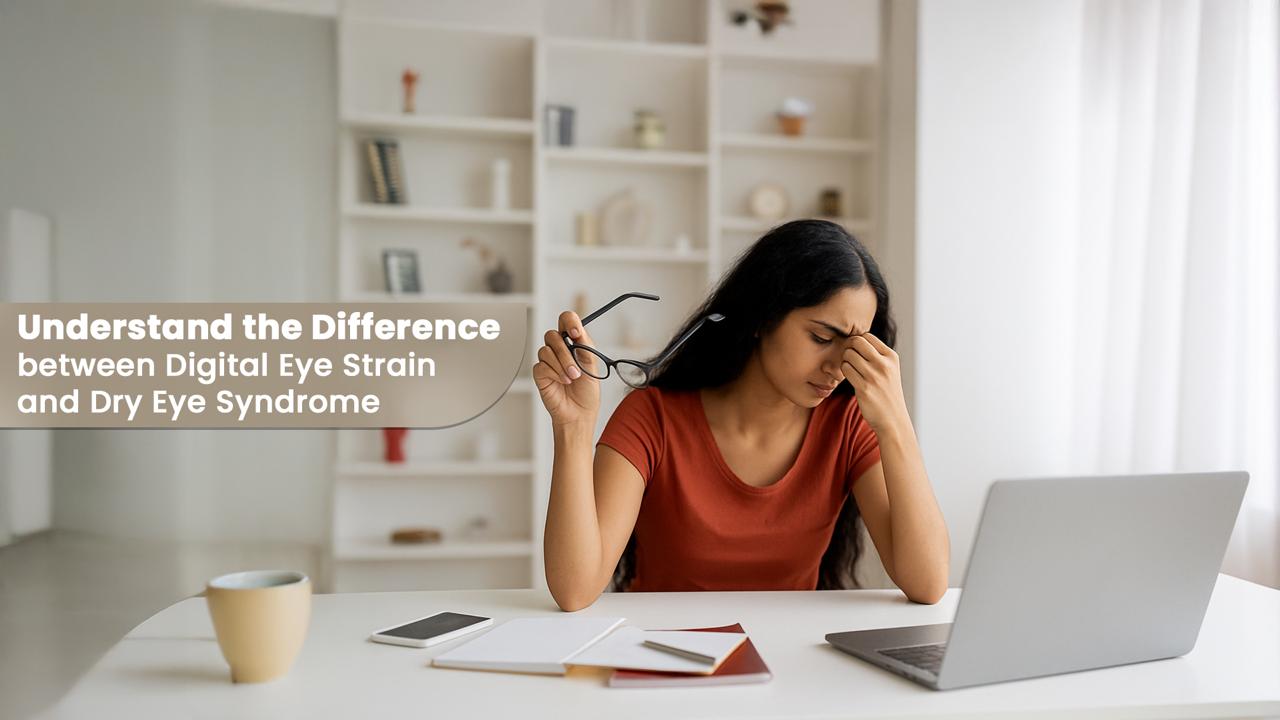
Understand the Difference between Digital Eye Strain and Dry Eye Syndrome
Digital Eye Strain vs Dry Eye Syndrome: Know the Difference
In our digital world, long hours spent in front of screens have become a daily routine for work, study, or entertainment. Many people experience discomfort in their eyes, with symptoms such as redness, irritation, fatigue and blurred vision. While these symptoms may seem similar, they can arise from different eye conditions, digital eye strain, and dry eye syndrome.
Understanding the difference between the two is crucial for quick and effective treatment and prevention. Misinterpreting one for the other can lead not only to wrong treatment but also prolonged discomfort. Let us find out the key differences, causes, symptoms, and treatment strategies for both digital eye strain and dry eye syndrome.
Digital Eye Strain, Causes and Symptoms
Digital eye strain, also known as computer vision syndrome, affects people who spend more than two hours a day looking at digital screens, like computers, tablets, smartphones or TVs. Common causes are excessive screen time, poor lighting or screen glare, as also incorrect screen positioning, infrequent blinking and poor posture during screen use.
Symptoms of digital eye strain include eye fatigue or tiredness, blurred or double vision, headaches, neck and shoulder pain, difficulty in focusing, and burning or itching sensation in the eyes. These symptoms usually subside after taking a break from screen use. However, screen habits without corrective measures can worsen the symptoms over time.
Dry Eye Syndrome, Causes and Symptoms
A chronic condition where the eyes do not produce enough tears or the quality of tears is poor. Resulting inflammation and damage to the surface of the eye, leads to discomfort and vision issues. Common causes are ageing, hormonal changes, use of certain medications, environmental conditions, long-term contact lens use and health conditions like rheumatoid arthritis, diabetes or thyroid.
Symptoms of dry eye syndrome include gritty or sandy feeling in the eyes, redness and irritation, sensitivity to light, watery eyes, blurred vision, especially after reading or screen use and eye discomfort that does not improve with rest. Unlike digital eye strain, dry eye syndrome often requires ongoing management with artificial tears, medications or medical intervention.
Can You Have Both the Conditions
Yes, it is quite possible. In fact, dry eyes after using the computer is a common complaint. Digital screen exposure reduces blinking rate, which aggravates dryness. As a result, individuals may suffer from both computer-related eye strain and dry eye symptoms simultaneously.
A detailed eye examination is essential to evaluate tear film quality, blinking pattern and other diagnostic markers to determine the correct condition or the presence of both.
How to Prevent and Manage the Conditions
To reduce and manage digital eye strain, every 20 minutes, look at something 20 feet away for 20 seconds (20-20-20 rule), increase text size, reduce screen brightness and use blue light filters, keep the screen at eye level and at least an arm’s length away, use anti-glare screens or position screens away from light sources, make a conscious effort to blink regularly to keep your eyes lubricated.
To prevent and treat dry eye syndrome, use lubricating eye drops to maintain tear moisture. Wear wrap-around glasses or use humidifiers indoors. Drink adequate water to maintain hydration levels. Include omega-3 fatty acids, vitamin A and antioxidants in your diet. For persistent cases, doctors may prescribe anti-inflammatory drops, punctal plugs or other advanced treatments.
When To Visit Rotary Techno Netralaya
As early as possible.Proper diagnosis by our ophthalmologist can differentiate between digital eye strain and dry eyes and guide you to the right treatment. At Rotary Techno Netralaya, we provide advanced diagnostic tools and personalized care plans to ensure your eye health remains protected in today’s digital age.
While digital eye strain and dry eye syndrome share some overlapping symptoms, they are fundamentally different conditions. The former is a short-term problem related to screen usage, while the latter is a chronic issue involving tear production. By adopting healthy screen habits and seeking timely medical advice, you can protect your eyes from both conditions and enjoy clear, comfortable vision every day.
Stay Updates
Subscribe to our newsletter.
